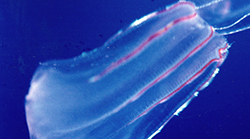Pink Comb Jelly
Scientific Name
Beroe ovata
Distribution
The pink comb jelly is present in lower Chesapeake Bay in late summer and fall.
Sting
Ctenophores like the pink comb jelly do not sting. Instead, their tentacles possess special adhesive cells called colloblasts that release a sticky, mucus-like substance to trap prey.
Size & Shape
Adult comb jellies are about the size of a golf ball, with a barrel-shaped body. Unlike its cousin the sea walnut, the body of the pink comb jelly lacks lobes.
Color
As the common name implies, the pink comb jelly is pinkish or brownish. The radiating "combs" that give the animal its name are made up of numerous microscopic cilia that produce a rainbow-like iridescence when they beat to and fro.
Food & Diet
Beroe feeds primarily on the other common ctenophore in the Bay, the sea walnut.

